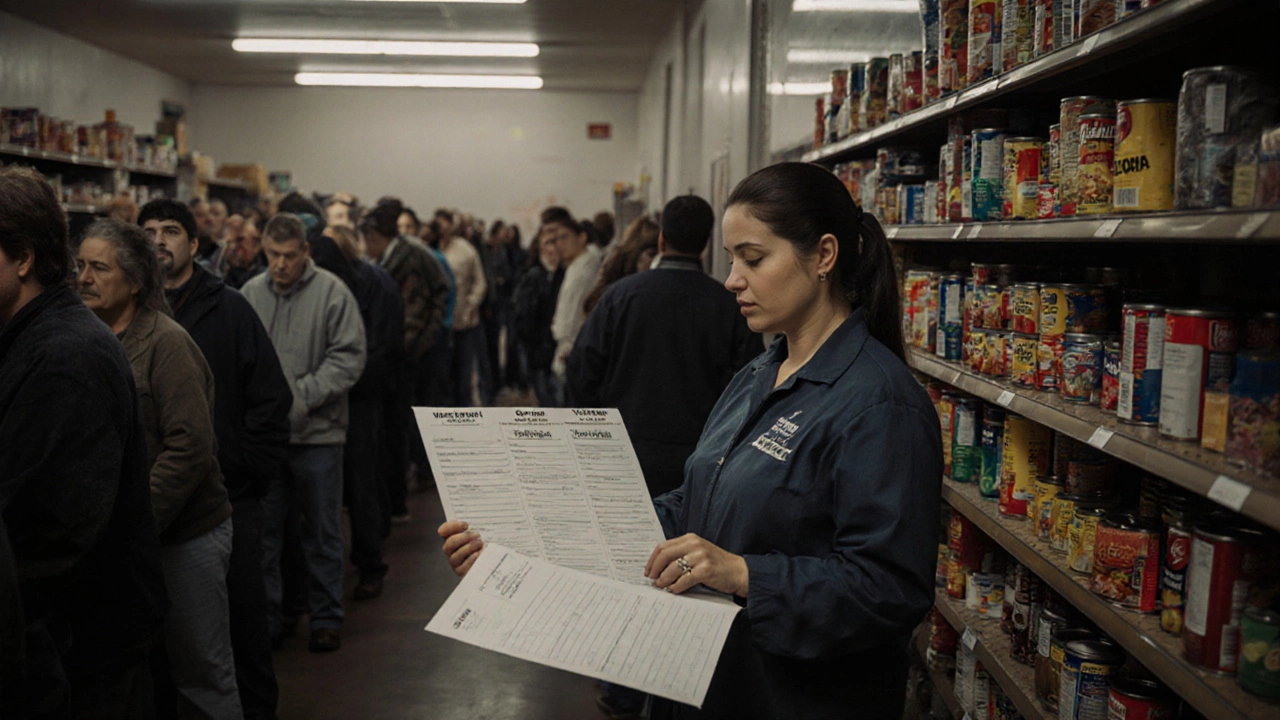Is There a Shortage of Volunteers? What’s Really Going On
 Nov, 16 2025
Nov, 16 2025
Micro-Volunteering Impact Calculator
Calculate how your small, flexible volunteer contributions can create meaningful impact over time. Discover how even 15 minutes a week can make a real difference in your community.
It’s 7 a.m. on a Saturday. The food bank is already packed with people waiting for groceries. The volunteer coordinator checks the sign-in sheet. Only three people showed up. They were supposed to have twelve. This isn’t rare. It’s happening everywhere-from animal shelters to youth mentoring programs to senior meal deliveries. The question isn’t whether there’s a volunteer shortage. The question is: why now, and what can actually be done about it?
Volunteer numbers are dropping, but not because people don’t care
Between 2019 and 2024, the number of adults volunteering regularly in the U.S. dropped by 17%, according to the Corporation for National and Community Service. That’s over 5 million fewer people showing up weekly to help. The same trend shows up in Canada, the UK, and Australia. You’d think a global crisis like a pandemic, followed by economic stress and political division, would bring people together. But it’s doing the opposite-pushing people away from formal volunteering.
It’s not that people are selfish. It’s that the old model of volunteering doesn’t work anymore. People still want to help. They’re just not signing up for 4-hour shifts every Tuesday anymore. They’re scrolling through Instagram and seeing a neighbor organize a neighborhood clean-up in two hours. They’re donating $10 to a GoFundMe instead of spending a Sunday sorting clothes. The way we ask people to help has become outdated.
The four big reasons volunteers are walking away
Nonprofits keep saying, “We need more volunteers!” But they’re often asking for the wrong things. Here’s what’s really driving people off:
- Time inflexibility - Most volunteer roles still demand fixed hours. If you work two jobs, pick up your kid at 3:30, and need to be home by 6, you can’t commit to 9-1 a.m. on Saturdays. No one’s asking if your schedule fits.
- Too much red tape - Background checks, training sessions, uniforms, orientation meetings. It’s not that people mind doing good work. They mind being treated like employees before they’ve even held a box of canned soup.
- No real impact - Volunteers want to see results. If you spend three hours stuffing envelopes that never get mailed, you feel useless. If you hand a meal to someone who says “thank you” and tells you their story, you feel like you mattered.
- Burnout culture - Longtime volunteers are exhausted. They’ve been carrying the load for years while organizations hire fewer paid staff. When the same five people show up every week, it’s not dedication-it’s desperation.

What’s working instead? The new model of volunteering
Some organizations are fixing this. They’re not begging. They’re adapting.
In Portland, a homeless outreach group stopped asking for weekly volunteers. Instead, they launched “Help in 90 Minutes.” You sign up online, pick a day, show up for a coffee and a sandwich delivery route. No training. No uniform. Just show up, hand out food, take photos (if you want), and leave. Within six months, they doubled their volunteer numbers-and kept 70% of them coming back.
In Chicago, a youth center stopped running after-school tutoring programs with fixed schedules. Instead, they created “Skill Swaps.” A graphic designer comes in for an hour to teach teens how to build a portfolio. A retired nurse teaches basic first aid. A college student helps with college applications. No formal title. No time commitment. Just skills shared on demand.
These aren’t gimmicks. They’re responses to how people live now. Volunteering doesn’t have to mean a weekly commitment. It can mean showing up once. Or helping remotely. Or donating your expertise instead of your time.
It’s not just about numbers-it’s about trust
Many volunteers don’t leave because they’re busy. They leave because they feel used. One woman told me she volunteered at a food bank for two years. Every time she asked how the donations were used, she got vague answers. Then she found out the organization spent $40,000 on a new logo and branding campaign while the shelves were still half-empty.
People don’t mind working hard. They mind working for organizations that don’t treat them like partners. Transparency matters. If you’re asking someone to give their time, tell them where their effort goes. Show them the receipts. Share the wins-and the failures.
Organizations that share monthly impact reports-“Last month, 120 volunteers helped serve 8,300 meals. We ran out of canned beans. Here’s how we’re fixing it.”-see volunteer retention rates 3x higher than those that don’t.

What nonprofits can do right now
You don’t need a big budget. You need a mindset shift.
- Offer micro-volunteering - Tasks that take 15-60 minutes: phone calls to seniors, writing thank-you notes, tagging photos online, translating a flyer.
- Remove barriers - Skip the 2-hour orientation. Let people start with one task. Let them opt out anytime.
- Let people choose how they help - Not everyone wants to serve food. Some want to design websites. Others want to drive a van. Let them pick.
- Recognize fast and often - A simple “thank you” text after a shift. A shout-out on social media. A handwritten note. These cost nothing and mean everything.
- Stop glorifying burnout - Don’t praise the volunteer who shows up 7 days a week. Praise the one who shows up once-and comes back next month.
The future of volunteering isn’t bigger-it’s better
The volunteer shortage isn’t a crisis of numbers. It’s a crisis of relevance. We’re asking people to do things the way we did them 20 years ago. But life doesn’t work that way anymore. People are stretched thin. They’re tired. They want to help, but they need to feel respected, seen, and effective.
The organizations that survive aren’t the ones with the biggest volunteer lists. They’re the ones that make helping easy, meaningful, and human.
Volunteering isn’t dead. It’s just changing shape. And if you’re ready to meet people where they are-you’ll find them.
Why are fewer people volunteering today than five years ago?
Fewer people are volunteering because traditional volunteer models don’t match modern lifestyles. People are juggling multiple jobs, caregiving, and mental health challenges. Long, inflexible shifts, excessive paperwork, and unclear impact make volunteering feel like a chore instead of a meaningful act. Many still want to help-they just don’t want to commit to weekly 4-hour blocks. They prefer short, flexible, and high-impact opportunities.
Can I still make a difference if I only have an hour a month?
Absolutely. One hour a month can change someone’s day. You could make a phone call to a lonely senior, help organize a donation drive, translate a flyer, or share a nonprofit’s post on social media. Many organizations now offer “micro-volunteering” tasks that take 15-60 minutes. These small acts add up-and they’re often more sustainable than trying to force yourself into a weekly commitment you can’t keep.
Do nonprofits really need more volunteers, or just better ones?
It’s both. They need more people-but they also need the right kind of support. Many nonprofits rely on volunteers to do paid staff work because they’re underfunded. That’s not sustainable. The goal isn’t just to fill slots-it’s to build systems where volunteers are respected, their time is valued, and their contributions are matched with real needs. Better systems mean fewer burnouts and more long-term engagement.
What’s the difference between volunteering and donating money?
Donating money helps nonprofits pay for food, rent, and staff. Volunteering provides human connection, labor, and local knowledge. The best outcomes happen when both exist. A food bank can’t run without trucks, but it also needs volunteers to sort and deliver. A shelter can buy blankets, but it needs someone to sit with a scared teen. Money keeps the lights on. Volunteers make the mission feel human.
Are young people volunteering less than older generations?
It’s not that young people volunteer less-they volunteer differently. Gen Z and millennials are less likely to join formal organizations. But they’re more likely to organize pop-up cleanups, fundraise online, or use skills like graphic design or social media to support causes. They prefer action over affiliation. Nonprofits that treat them as partners, not just volunteers, are seeing higher engagement from younger demographics.
If you’re looking to help but don’t know where to start, try this: find one small thing you care about-animals, kids, seniors, the environment-and ask a local group, “What’s one thing you need help with that takes less than an hour?” You might be surprised how easy it is to start.
